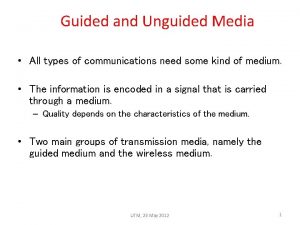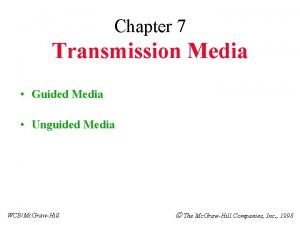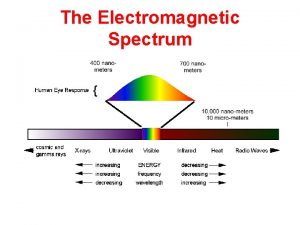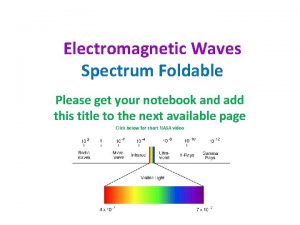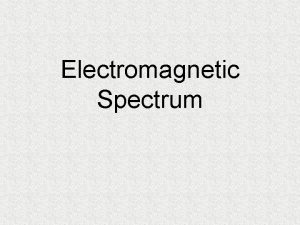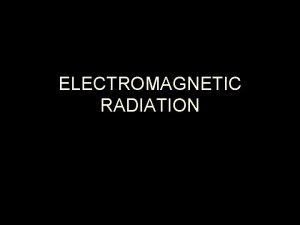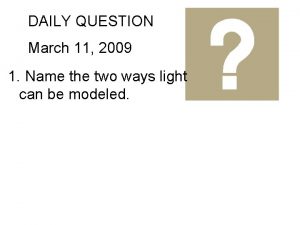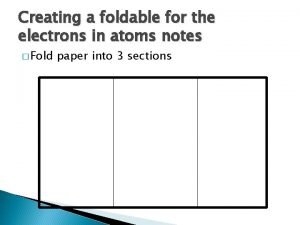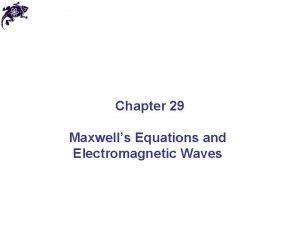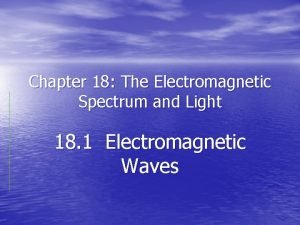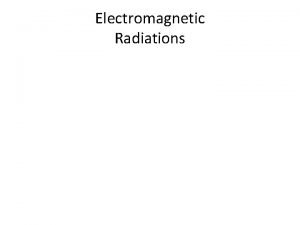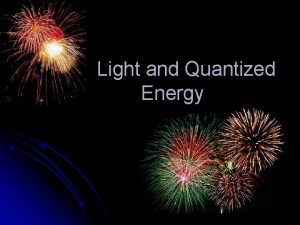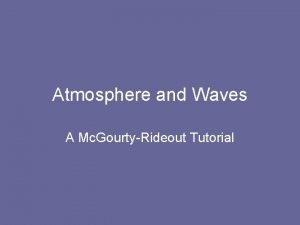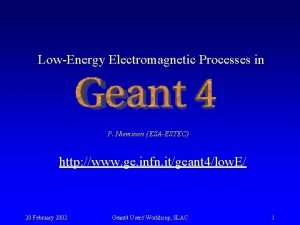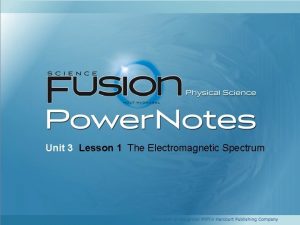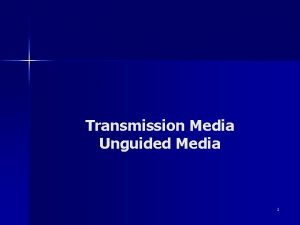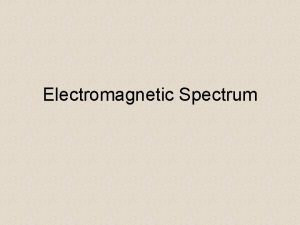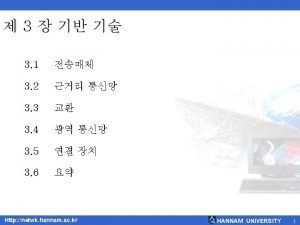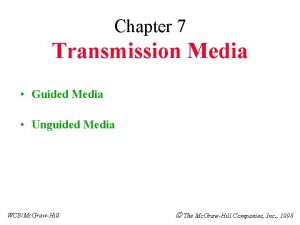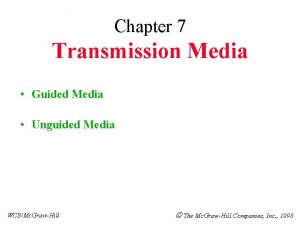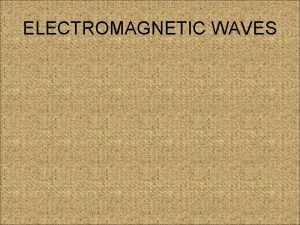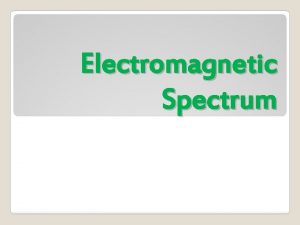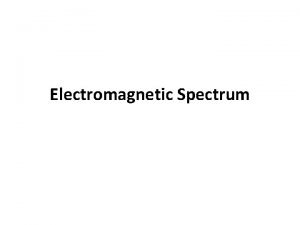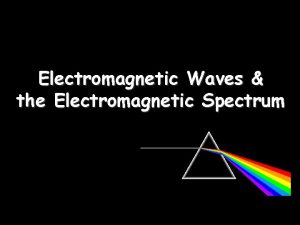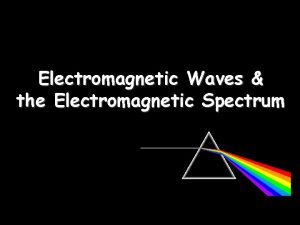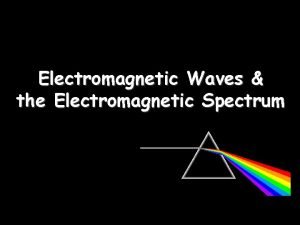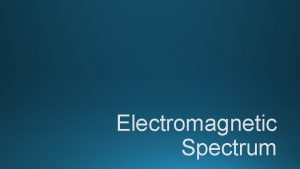Module 3 2 Transmission Media Electromagnetic Spectrum Unguided

















- Slides: 17

Module 3. 2: Transmission Media • • Electromagnetic Spectrum • Unguided Transmission Media – Terrestrial Microwave – Satellite – Radio – IR – Cellular Telephony Guided Transmission Media – Twisted Pair – Coaxial cable – Optical fiber K. Salah 1

Electromagnetic Spectrum K. Salah 2

Guided Transmission Media • • • Twisted Pair Coaxial cable Optical fiber K. Salah 3

Twisted Pair • • Most common medium • Within buildings – To private branch exchange (PBX) • For local area networks (LAN) – 10 Mbps or 100 Mbps • Pros and Cons: – Cheap – Easy to work with – Low data rate – Short range, about 100 meters. Telephone network – Between house and local exchange (subscriber loop) K. Salah 4

Unshielded and Shielded TP • • Unshielded Twisted Pair (UTP) – Ordinary telephone wire – Cheapest – Easiest to install – Suffers from external EM interference Shielded Twisted Pair (STP) – Metal braid or sheathing that reduces interference – More expensive – Harder to handle (thick, heavy) – Capacity 10 -155 Mbps UTP Categories • Cat 3 – up to 16 MHz – Voice grade found in most offices • Cat 4 – up to 20 MHz • Cat 5 – up to 100 MHz – Commonly pre-installed in new office buildings RJ-11 vs. RJ-45 K. Salah 5 • RJ-11 is a typical UTP phone connector. Has 2 pairs. • RJ-45 is a UTP connector. Has 4 pairs.

Coaxial Cable • • Most versatile medium • Long distance telephone transmission – Can carry 10, 000 voice calls simultaneously – Being replaced by fiber optic Television distribution – Ariel to TV – Cable TV • Short distance computer systems links • Local area networks K. Salah Transmission Characteristics z Analog y Amplifiers every few km y Closer if higher frequency y Up to 500 MHz z Digital y Repeater every 1 km y Closer for higher data rates 6

Optical Fiber • Greater capacity – Data rates of hundreds of Gbps • • Smaller size & weight Lower attenuation Electromagnetic isolation Greater repeater spacing – 10 s of km at least K. Salah 7

Transmission Characteristics z Act as wave guide for 1014 to 1015 Hz y Portions of infrared and visible spectrum z Light Emitting Diode (LED) used in MMF y Cheaper y Wider operating temp range y Last longer z Injection Laser Diode (ILD) used in SMF y More efficient y Greater data rate z Wavelength Division Multiplexing (WDM) using light prisms. K. Salah MMF vs. SMF 8

Comparison Cable Type Cost 1 = lowest 5 = highest Typical Capacity Installation 1 = easy 5 = hard Max Cable Length EMI Resistance 1 = low 5 = high Coaxial. Thinnet 2 10 Mbps 2 185 meters 2 Coaxial. Thicknet 4 10 Mbps 3 500 meters 2 UTP 1 10 -100 Mbps 1 100 meters 1 STP 3 16 -155 Mbps 2 100 meters 2 Fiber-optic 5 100+ Mbps 5 Multiple kilometers 5 K. Salah 9

Wireless Transmission • • Unguided media • Directional – Focused beam – Careful alignment required • Omnidirectional – Signal spreads in all directions – Can be received by many antennae Frequencies Transmission and reception via antenna K. Salah 10 z 2 GHz to 40 GHz y Microwave y Highly directional y Point to point y Satellite z 30 MHz to 1 GHz y Omnidirectional y Broadcast radio z 3 x 1011 to 2 x 1014 y Infrared y Local pt-pt confined area

Types of Radio Propagation K. Salah 11

Microwave Satellite Microwave Terrestrial Microwave • • • z Satellite is relay station z Satellite receives on one frequency, amplifies or repeats signal and transmits on another frequency z Requires geo-stationary orbit y Height of 35, 784 km z GEO vs. LEO z Frequency Bands: C, Ku, and Ka z Television z Long distance telephone z Private business networks Parabolic dish Focused beam Line of sight Long haul telecommunications Higher frequencies give higher data rates K. Salah 12

Wide Area: Satellite Systems • • Cover very large areas • • Dish antennas, or bulky handsets Different orbit heights – GEOs (39000 Km), LEOs (2000 Km), MEOs (9000 km) – GEO is stationary. You need 3 to cover whole planet – LEO and MEO orbit the earth every one hour Optimized for one-way transmission, location positioning, GPS systems, Satellite Radio – Radio (XM, DAB) and movie (Sat. TV) broadcasting – Killed MMDS wireless TV offerings. – Future: sat. TV (eg: direct. TV) in your car • • Most two-way systems struggling or bankrupt – Expensive alternative to terrestrial cellular system (2 G) Trucking fleets, journalists in wild areas, Oil rigs K. Salah 13

LEO and MEO • • Used in GPS • 54 for LEOs to cover the whole planet • Could have multiple readings for increased precision and reliability. 24 MEOs are need to cover the whole planet K. Salah 14

WLAN • Benefits of Ethernet WLAN – Cheap – Faster to deploy – Mobility – Watch for security Ø Need for authentication Ø Need for encryption during transmission • • • What is an Access Point? • Bluetooth gives 1 Mbps. Bluetooth networks PDAs or cell phones with PCs. Operates in a short diameter (10 meters). – Operates at 2. 4 - 2. 4835 GHz – May have interference with Ethernet WLAN APs A typical diameter is a room for one AP about 40 meters Frequencies used and data rate – IEEE 802. 11 b operates at 2. 4 GHz range and gives 11 Mbps – IEEE 802. 11 a operates at 5 GHz range and gives 54 Mbps – IEEE 802. 11 g operates at 2. 4 GHz range and gives 54 Mbps K. Salah 15

Others IR (Infrared) z Modulate noncoherent infrared light z Line of sight (or reflection) z Blocked by walls z e. g. TV remote control, IRD port Broadcast Radio • • • Omnidirectional FM radio UHF and VHF television Line of sight Suffers from multipath interference – Reflections K. Salah 16

Cellular System Cellular Bands K. Salah 17
 Compare guided and unguided media
Compare guided and unguided media Wcb
Wcb Shortest to longest wavelength
Shortest to longest wavelength What waves are produced by stars and galaxies
What waves are produced by stars and galaxies Electromagnetic song lyrics
Electromagnetic song lyrics Electromagnetic spectrum foldable
Electromagnetic spectrum foldable Characteristics of gamma rays
Characteristics of gamma rays Electromagnetic spectrum micrometers
Electromagnetic spectrum micrometers Electromagnetic spectrum mnemonic
Electromagnetic spectrum mnemonic Electromagnetic spectrum foldable
Electromagnetic spectrum foldable Electromagnetic waves formula
Electromagnetic waves formula Chapter 18 electromagnetic spectrum and light
Chapter 18 electromagnetic spectrum and light Kesler science electromagnetic spectrum answer key
Kesler science electromagnetic spectrum answer key Electromagnetic spectrum
Electromagnetic spectrum Types of radiation in the electromagnetic spectrum
Types of radiation in the electromagnetic spectrum What is the electromagnetic spectrum
What is the electromagnetic spectrum Electromagnetic spectrum
Electromagnetic spectrum Lesson 1: the electromagnetic spectrum
Lesson 1: the electromagnetic spectrum
